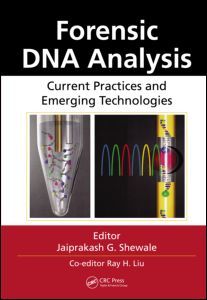Forensic DNA Analysis Current Practices and Emerging Technologies
Coordonnateurs : Shewale Jaiprakash G., Liu Ray H.

The field of forensic DNA analysis has grown immensely in the past two decades and genotyping of biological samples is now routinely performed in human identification (HID) laboratories. Application areas include paternity testing, forensic casework, family lineage studies, identification of human remains, and DNA databasing. Forensic DNA Analysis: Current Practices and Emerging Technologies explores the fundamental principles and the application of technologies for each aspect of forensic DNA analysis.
The book begins by discussing the value of DNA evidence and how to properly recognize, document, collect, and store it. The remaining chapters examine:
- The most widely adopted methods and the best practices for DNA isolation from forensic biological samples and human remains
- Studies carried out on the use of both messenger RNA and small (micro) RNA profiling
- Real-time polymerase chain reaction (PCR) methods for quantification and assessment of human DNA prior to genotyping
- Capillary electrophoresis (CE) as a tool for forensic DNA analysis
- Next-generation short tandem repeat (STR) genotyping kits for forensic applications, the biological nature of STR loci, and Y-chromosome STRs (Y-STRs)
- Mitochondrial DNA (mtDNA) sequence analysis
- Single nucleotide polymorphisms (SNPs) and insertion/deletion polymorphisms (indels) in typing highly degraded DNA
- Deep-sequencing technologies
- The current state of integrated systems in forensic DNA analysis
The book concludes by discussing various aspects of sample-processing training and the entities that provide such training programs. This volume is an essential resource for students, researchers, teaching faculties, and other professionals interested in human identification/forensic DNA analysis.
Sample Collection, Sample Storage, and DNA Extraction. Forensic DNA Evidence Collection at a Crime Scene: An Investigator’s Commentary. Optimizing Storage and Handling of DNA Extracts. Extraction of DNA from Forensic Biological Samples for Genotyping. Extraction of DNA from Human Remains. Sample Assessment. RNA Profiling for the Identification of the Tissue Origin of Dried Stains in Forensic Biology. Assessment of DNA Extracted from Forensic Samples Prior to Genotyping. STRs—Proven Genotyping Markers. Principles, Practice, and Evolution of Capillary Electrophoresis as a Tool for Forensic DNA Analysis. Next-Generation STR Genotyping Kits for Forensic Applications. Biology and Genetics of New Autosomal STR Loci Useful for Forensic DNA Analysis. Hidden Variation in Microsatellite Loci: Utility and Implications for Forensic DNA. Additional Y-STRs in Forensics: Why, Which, and When. Expanding the Genotyping Capabilities. Forensic Mitochondrial DNA Analysis: Current Practice and Future Potential. Applications of Autosomal SNPs and Indels in Forensic Analysis. Deep-Sequencing Technologies and Potential Applications in Forensic DNA Testing. Sample-to-Result STR Genotyping Systems: Potential and Status. Training. Training of Forensic DNA Scientists—A Commentary. Index.
Jaiprakash G. Shewale, Ray H. Liu
Date de parution : 08-2013
17.8x25.4 cm
Date de parution : 03-2021
17.8x25.4 cm
Thèmes de Forensic DNA Analysis :
Mots-clés :
Forensic DNA Analysis; Forensic DNA; next generation sequencing; Str Locus; DNA Extract; short tandem repeat; Str Analysis; forensic casework; Forensic DNA Laboratory; single nucleotide polymorphism; Female DNA; Str Typing; DNA Analysis; Male DNA; Str Kit; Degraded DNA Sample; DNA Separation; National DNA Database; DNA IQ; NA NA NA NA NA; DNA Recovery; DNA Sample; DNA Fragment; Str Marker; Nuclear DNA; FTA Card; Single Base Resolution; DNA Storage; DNA Evidence



